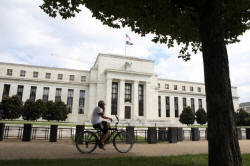Powell sets Fed's course with data-based judgment
 Send a link to a friend
Send a link to a friend
 [August 27, 2018]
By Howard Schneider and Ann Saphir [August 27, 2018]
By Howard Schneider and Ann Saphir
JACKSON HOLE, Wyo. (Reuters) - Federal
Reserve Chair Jerome Powell has begun putting his stamp on the U.S.
central bank as someone who will rely more on data-informed judgment and
less on some of the models and theoretical values that have shaped the
Fed’s course in recent years but that Powell has said can be false
guides.
In doing so he may be laying the groundwork for a longer-than-expected
rate-increase cycle, as discussion intensifies among policymakers about
what level of borrowing costs is appropriate in an economy that is
nearly back to full health. In addition, the full stimulative effects of
President Donald Trump's tax cuts and increased government spending may
not yet have presented themselves.
On the other hand, while the drag that many businesses fear could result
from uncertain trade policy has not materialized, if it does it could
force an earlier end to the Fed's rate-hike cycle.

Such two-way concerns are unfamiliar territory for a Fed that under
Powell's immediate predecessors had to focus mostly on just one kind of
risk: too-low inflation and sub-par growth. Now, with unemployment at
3.9 percent - below what most economists believe is sustainable -- and
inflation near the Fed's 2 percent goal, the economic terrain looks less
fragile.
In a keynote speech at the Kansas City Fed's annual symposium here on
Friday and in recent congressional testimony, Powell has laid out an
approach he sees suitable to that new terrain. It relies on using
judgment to balance risks on both sides, and he cautioned against
relying too much on roughly estimated variables like the so-called
neutral rate of interest.
The neutral rate is a theoretical level that in a healthy economy would
neither boost nor restrain investment and spending; it can move around
over time.
Powell leaned heavily on the idea that policymakers would have to feel
their way to their destination, citing incidents from Fed history in
which reliance on technical estimation led the central bank astray,
while reliance on intuition led to better outcomes.
"It's an informed intuition," said Atlanta Fed President Raphael Bostic,
who like other regional Fed officials talks with dozens of firms
regularly to get a sense of what might show up in economic data in one
or two months' time.
With a background in markets and law, that approach may play more to
Powell’s strengths, while lessening the influence of technicians who
have focused on issues like estimating neutral rates of interest and
full employment.
Those estimates are based on historical data and may not capture changes
to the economy that are in motion but have not yet been seen in the flow
of data -- the sort of situation that led former Fed Chair Alan
Greenspan to argue against rate increases in the late 1990s because he
felt rising productivity was not fully seen in government statistics.

[to top of second column] |

A cyclist passes the Federal Reserve building in
Washington, DC, U.S., August 22, 2018. REUTERS/Chris Wattie

"We’re getting to a place now where it’s less clear whether we should be
worried about weakness in the economy or too much strength," Bostic said
on the sidelines of the symposium, attended by all his fellow Fed
policymakers as well as central bank chiefs and economists from around
the world. "On some level I think it’s good for us all to be talking
about the fact that policy is much more bidirectional in its
possibilities."
The recently released minutes from the Fed's last meeting held an
important clue as well, acknowledging that statements about policy in
relation to an estimated neutral level “could convey a false sense of
precision.” That could be even more of a dilemma at a time when fiscal
stimulus and other developments might actually be shifting the neutral
rate higher, as many policymakers are beginning to suspect.
If that is the case, it would set the stage for the Fed to push rates
higher than currently expected while arguing that monetary policy was
not yet restricting the economy, but was rather appropriate for its
strengths.
The Fed's most recent projections point to two more rate hikes this year
and three in 2019, more than what markets currently anticipate. At the
same time, the Fed is shrinking its $4 trillion portfolio of bonds, a
process that is exerting upward pressure on some financial market and
consumer interest rates and as yet has no clear end point.
The Fed currently describes interest rates as "accommodative," a
statement that requires an estimate of the neutral level. That language
is expected to be jettisoned soon as rates continue rising, and does not
necessarily need to be replaced.

Beyond saying he sees further gradual rate hikes as likely appropriate,
Powell did not lay out a certain path for interest rates, cautioning
that preconceived notions of where policy should end up may steer the
Fed off course.
Along with the neutral rate of interest, the Fed is struggling with how
to assess background variables such as the level of unemployment that
could be reached without putting pressure on inflation. The general
thinking is that it has dropped, but finding that point has been
elusive.
“These are unobservables, and he's good about emphasizing that,” said
James Bullard, president of the St. Louis Fed. "As economists we often
fall in love with our models, I certainly fall in love with my models.
But at the same time I'm aware, and I have to remind myself all the time
about all the shortcomings of models."
(Reporting by Ann Saphir and Howard Schneider in Jackson Hole, Wyo.;
Editing by Dan Burns and Leslie Adler)
[© 2018 Thomson Reuters. All rights
reserved.] Copyright 2018 Reuters. All rights reserved. This material may not be published,
broadcast, rewritten or redistributed.
Thompson Reuters is solely responsible for this content. |